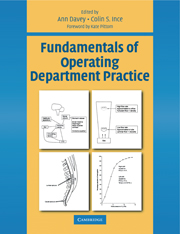Book contents
- Frontmatter
- Contents
- Contributors
- Preface
- Foreword
- Acknowledgements
- Introduction
- Chapter 1 The operating department practitioner, the patient and the law
- Chapter 2 Aspects of health and safety in the operating department
- Chapter 3 The caring practitioner
- Chapter 4 Strategies for infection control in the operating department
- Chapter 5 Sterilization, decontamination and the surgical field
- Chapter 6 The fundamentals of cardiovascular physiology
- Chapter 7 Fundamentals of respiratory physiology
- Chapter 8 Scientific principles in relation to the anaesthetic machine
- Chapter 9 Fundamentals of artificial ventilation of the lung
- Chapter 10 Scientific principles in relation to monitoring equipment
- Chapter 11 Scientific principles in relation to endoscopic, laser and radiological equipment
- Chapter 12 Pharmacological principles of drug administration
- Chapter 13 The pharmacology of drugs used in general anaesthesia
- Chapter 14 The local anaesthetic drugs - does the ideal agent exist?
- Chapter 15 The safe positioning of patients for surgery
- Chapter 16 Principles involved in the management and use of equipment
- Chapter 17 Understanding suture materials
- Chapter 18 Fundamentals ofpaediatric surgery and anaesthesia
- Chapter 19 Fundamentals of hyperthermia and hypothermia
- Chapter 20 Fundamentals of fluid and electrolyte balance during surgery
- Chapter 21 The physiology of blood and its administration
- Chapter 22 Fundamentals of pain relief
- Chapter 23 Fundamentals of dressings and drains in relation to wound healing
- Chapter 24 The recovery of patients from anaesthesia and surgery
- Chapter 25 Fundamentals of emergency and obstetric anaesthesia
- Chapter 26 Identification and management of anaesthetic emergencies
- Chapter 27 The fundamentals of emergency resuscitation
- Appendixes
- Index
Chapter 27 - The fundamentals of emergency resuscitation
Published online by Cambridge University Press: 05 October 2015
- Frontmatter
- Contents
- Contributors
- Preface
- Foreword
- Acknowledgements
- Introduction
- Chapter 1 The operating department practitioner, the patient and the law
- Chapter 2 Aspects of health and safety in the operating department
- Chapter 3 The caring practitioner
- Chapter 4 Strategies for infection control in the operating department
- Chapter 5 Sterilization, decontamination and the surgical field
- Chapter 6 The fundamentals of cardiovascular physiology
- Chapter 7 Fundamentals of respiratory physiology
- Chapter 8 Scientific principles in relation to the anaesthetic machine
- Chapter 9 Fundamentals of artificial ventilation of the lung
- Chapter 10 Scientific principles in relation to monitoring equipment
- Chapter 11 Scientific principles in relation to endoscopic, laser and radiological equipment
- Chapter 12 Pharmacological principles of drug administration
- Chapter 13 The pharmacology of drugs used in general anaesthesia
- Chapter 14 The local anaesthetic drugs - does the ideal agent exist?
- Chapter 15 The safe positioning of patients for surgery
- Chapter 16 Principles involved in the management and use of equipment
- Chapter 17 Understanding suture materials
- Chapter 18 Fundamentals ofpaediatric surgery and anaesthesia
- Chapter 19 Fundamentals of hyperthermia and hypothermia
- Chapter 20 Fundamentals of fluid and electrolyte balance during surgery
- Chapter 21 The physiology of blood and its administration
- Chapter 22 Fundamentals of pain relief
- Chapter 23 Fundamentals of dressings and drains in relation to wound healing
- Chapter 24 The recovery of patients from anaesthesia and surgery
- Chapter 25 Fundamentals of emergency and obstetric anaesthesia
- Chapter 26 Identification and management of anaesthetic emergencies
- Chapter 27 The fundamentals of emergency resuscitation
- Appendixes
- Index
Summary
INTRODUCTION
Resuscitation is the process by which an individual is brought ‘back to life’ or consciousness. Cardiorespiratory resuscitation is the process by which an individual's respiration and circulation may be temporarily supported to keep them alive long enough for the cause of the arrest to be treated, if this is possible. Ideally, all clinical personnel, both medical and non-medical, should be familiar with the principles and practice of cardiopulmonary resuscitation.
In the United Kingdom, the Resuscitation Council (UK) runs an excellent Advanced Life Support Provider course, which covers the principles and practice of life support in detail. This chapter provides an overview of the subject of resuscitation.
RECOGNITION AND ASSESSMENT
The importance of the recognition and assessment of the suspected cardiorespiratory arrest cannot be overstated. Failure to recognize and respond to the arrest wastes valuable time and reduces the chance of a successful outcome.
A respiratory arrest occurs when an individual stops breathing and becomes apnoeic. A cardiac arrest is when the heart fails to pump enough blood to maintain a pulse or blood pressure. If untreated, one always rapidly follows the other because, if breathing ceases, no oxygen enters the blood and the heart, brain and other vital organs are starved of oxygen. This hypoxia leads to the development of organ failure. Initially, because the brain has the greatest need for oxygen, it rapidly stops functioning properly and the patient loses consciousness. The brainstem is also affected and, shortly after, the heart ceases to beat effectively and the circulation fails, i.e. the blood pressure and pulse will be unrecordable. Without a circulation and the subsequent loss of tissue perfusion, damage to other vital organs will ensue.
If, on the other hand, the patient has a cardiac arrest the circulation fails first and the brain then becomes starved of oxygen-rich blood. Cerebral function is compromised and the patient rapidly becomes unconscious. Because the brain also contains the respiratory centre, which controls breathing, the breathing will become erratic and eventually stop. In this case, the respiratory arrest is secondary to a cardiac arrest.
Of all the vital organs which suffer injury following a cardiorespiratory arrest, the brain is the most vulnerable. Irreversible brain damage begins 3-4 min following a cardiorespiratory arrest. Not all parts of the brain, however, are damaged at the same rate.
- Type
- Chapter
- Information
- Fundamentals of Operating Department Practice , pp. 299 - 306Publisher: Cambridge University PressPrint publication year: 1999

